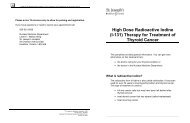Legionnaires' disease
Legionnaires' disease
Legionnaires' disease
Create successful ePaper yourself
Turn your PDF publications into a flip-book with our unique Google optimized e-Paper software.
Health<br />
Canada<br />
Santé<br />
Canada<br />
It’s Your Health<br />
LEGIONNAIRES’ DISEASE AND<br />
PONTIAC FEVER<br />
The Issue<br />
A bacterial infection called legionellosis is<br />
responsible for two distinct illnesses:<br />
Legionnaires’ <strong>disease</strong> and Pontiac fever.<br />
Legionnaires’ <strong>disease</strong> is a type of<br />
pneumonia, which can occur in outbreaks.<br />
It varies in severity, and is sometimes<br />
fatal. Pontiac fever is a milder flu-like<br />
illness without pneumonia.<br />
Background<br />
Legionnaires’ <strong>disease</strong> first became<br />
known in 1976, when an outbreak of<br />
pneumonia killed 34 people at an<br />
American Legion Convention in<br />
Philadelphia. The bacterium that caused<br />
the outbreak was named Legionella<br />
pneumophilia. Scientists later discovered<br />
that Legionella bacteria could also cause<br />
a milder type of infection, called Pontiac<br />
fever.<br />
How Legionellosis<br />
Spreads<br />
Legionella bacteria are found in water<br />
sources. People become infected by<br />
breathing in mist or steam containing the<br />
bacteria. Single cases of Legionnaires’<br />
<strong>disease</strong> are more common, but outbreaks<br />
do occur, and have been reported<br />
in hospitals, hotels, other large buildings,<br />
and on cruise ships. Outbreaks and<br />
individual cases have been traced to a<br />
number of specific sources, including:<br />
• water distribution systems (showers)<br />
• whirlpool spas and hot tubs<br />
• humidifiers<br />
•the cooling towers of large<br />
air-conditioning systems (e.g. in<br />
hotels, hospitals)<br />
Legionellosis is not spread from one<br />
person to another. You cannot contract<br />
Pontiac fever or Legionnaires’ <strong>disease</strong><br />
from an infected person.<br />
The Symptoms of<br />
Legionellosis<br />
Pontiac fever causes a flu-like illness.<br />
The symptoms include fever, lack of<br />
appetite, headache, and aching muscles.<br />
Pontiac fever is not associated with<br />
pneumonia. In most cases no treatment<br />
is required, and people recover within<br />
two to five days.<br />
Legionnaires’ <strong>disease</strong> is a type of<br />
pneumonia that varies in severity from<br />
relatively mild to fatal. The symptoms can<br />
include high fever, chills and a cough, as<br />
well as fatigue, headache, aching<br />
muscles, chest pain, and loss of appetite.<br />
Sometimes there is also nausea,<br />
diarrhea, or a change in a person’s mental<br />
condition, including confusion or memory<br />
loss. Special tests are usually required to<br />
confirm that the illness has been caused<br />
by Legionella bacteria.<br />
Anyone with symptoms of Legionnaires’<br />
<strong>disease</strong> should seek immediate medical<br />
attention. Many cases are treated<br />
successfully with antibiotics, such as<br />
• respiratory therapy devices<br />
(in hospitals)
Health<br />
Canada<br />
Santé<br />
Canada<br />
It’s Your Health<br />
erythromycin. Approximately 10<br />
to 15 percent of people with<br />
Legionnaires’ <strong>disease</strong> may die,<br />
but this varies with age and<br />
over-all health, and can also<br />
depend on how quickly the<br />
person receives the right<br />
medical treatment.<br />
Risk Factors for<br />
Legionellosis<br />
Anyone can get legionellosis, but<br />
the risk of developing <strong>disease</strong> is<br />
greater for people who are middle<br />
aged and older. It is uncommon<br />
for people less than 20 years<br />
old to get legionellosis. The<br />
following people are also at<br />
greater risk:<br />
• smokers<br />
• people with a chronic lung or<br />
kidney <strong>disease</strong><br />
• people with diabetes<br />
• people with weakened<br />
immune systems due to<br />
conditions such as cancer or<br />
an organ transplant<br />
People in certain occupations,<br />
such as those who do<br />
maintenance work on large airconditioning<br />
systems, may be at<br />
increased risk for exposure to<br />
Legionella bacteria. However, if<br />
exposed, an individual’s risk of<br />
developing a serious infection<br />
would depend on the factors<br />
listed above.<br />
Minimizing Your<br />
Risk<br />
Legionellosis is not a common<br />
<strong>disease</strong>, and the risk of getting it<br />
is generally quite low.<br />
Minimizing your risk in large<br />
buildings, such as hotels and<br />
hospitals, is difficult because you<br />
cannot predict where or when the<br />
bacteria will be present. The key<br />
to controlling the risk of infection<br />
from these sources is a combination<br />
of good engineering practices<br />
and good infection control<br />
policies and guidelines.<br />
In your home, you can minimize<br />
risks through the proper<br />
maintenance of all mist-producing<br />
devices, such as shower heads,<br />
hot tubs, whirlpools and humidifiers.<br />
Make sure you clean and<br />
disinfect these devices regularly<br />
according to the manufacturers’<br />
directions.<br />
Health Canada’s<br />
Role<br />
Health Canada collects information<br />
about the number of cases of<br />
legionellosis in Canada as part of<br />
its work with provincial and<br />
territorial public health officials to<br />
monitor and analyze the<br />
incidence of infectious <strong>disease</strong>s.<br />
Health Canada also develops<br />
guidelines to prevent and control<br />
the spread of infections acquired<br />
in health care facilities, such as<br />
hospitals. When requested,<br />
Health Canada will help to<br />
investigate outbreaks of infectious<br />
<strong>disease</strong>s.<br />
In addition, Health Canada<br />
participates in public information<br />
initiatives, and works globally with<br />
other countries to develop and<br />
implement strategies to reduce or<br />
eradicate infectious <strong>disease</strong>s.<br />
Need More Info?<br />
For more about Health Canada’s<br />
Infection Control Guidelines, visit:<br />
http://www.hc-sc.gc.ca/pphb-dgspsp/<br />
dpg_e.html#infection<br />
See also Health Canada’s It’s<br />
Your Health fact sheet on<br />
“Cool Mist Humidifiers” at:<br />
http://www.hc-sc.gc.ca/english/<br />
iyh/products/humidifiers.htm<br />
For more about Legionnaires’<br />
<strong>disease</strong> and Occupational Health<br />
from the Canadian Centre for<br />
Occupational Health and Safety,<br />
visit:<br />
http://www.ccohs.ca/oshanswers/<br />
<strong>disease</strong>s/legion.html<br />
Other Web sites of interest<br />
include:<br />
U.S. Centers for Disease Control<br />
and Prevention Web site on<br />
legionellosis at:<br />
http://www.cdc.gov/ncidod/dbmd/<br />
<strong>disease</strong>info/legionellosis_g.htm<br />
Additional It’s Your Health articles<br />
can be found at:<br />
www.healthcanada.ca/iyh<br />
You can also call (613) 957-2991<br />
ISBN # H50-3/131-2003E-PDF<br />
Catalogue # 0-662-35496-6<br />
Original: February 2004<br />
©Her Majesty the Queen in Right of Canada, represented by the Minister of Health, 2004














